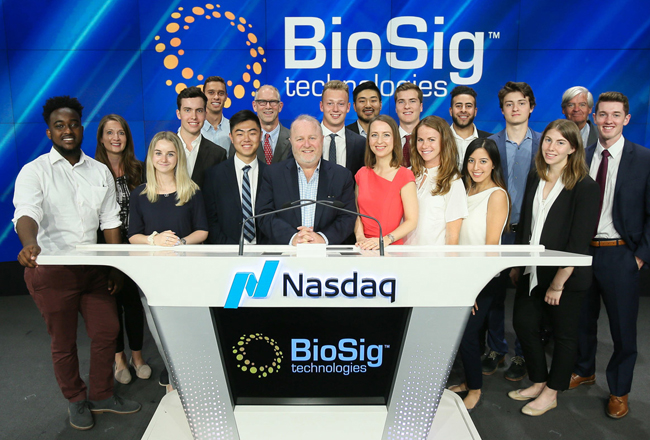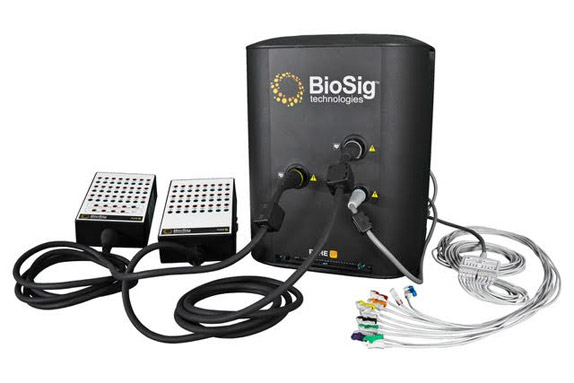BioSig gaining momentum with proprietary AFib-treating tech
Westport”™s BioSig is looking to set the pace when it comes to medical technology ”” not a bad place to be, given that its specialty is in cardiology.

BioSig operates in the field of bioelectronic medicine, a relatively new and growing field that focuses on how targeted electrical signals in the body can help diagnose and treat a wide range of diseases. BioSig”™s initial focus is on heart disease, specifically atrial fibrillation (AFib) or irregular heartbeat.
“Roughly one out of two patients who have surgery to treat irregular heartbeats fail the procedure and need to have a second one,” BioSig founder and CEO Ken Londoner told the Business Journal. “It”™s not a trivial technical challenge, which is why it hasn”™t been solved.”
Working with a team of engineers, Londoner created BioSig in Los Angeles in 2009 to address what many see as shortcomings in electrophysiology (EP) technology in operating rooms; namely, that many existing systems are outdated.
Since that time, BioSig has developed a first-of-its-kind technology, Pure EP, which received U.S. Food and Drug Administration market clearance in 2018. Londoner noted that the firm”™s technology now has 34 patents.
The system, powered by a unique hardware architecture, allows a full range of cardiac analog signals to be acquired in a raw, streamlined and unfiltered format. That data is then converted into a digital modality powered by advanced signal processing software for unlimited real-time data analysis. Londoner said that the platform is designed to improve signal fidelity and uncover the full range of electrocardiagram and intracardiac signals.
 While hospitals have used EP technology in the past to treat cardio patients, Londoner said one of the challenges has been “the signal quality issue. It gets degraded by all the other medical equipment that”™s operating on the same frequency. It”™s like having five FM radio stations all broadcasting on 95.5 at the same time ”” you”™re not getting the information that you want.”
While hospitals have used EP technology in the past to treat cardio patients, Londoner said one of the challenges has been “the signal quality issue. It gets degraded by all the other medical equipment that”™s operating on the same frequency. It”™s like having five FM radio stations all broadcasting on 95.5 at the same time ”” you”™re not getting the information that you want.”
On March 31, BioSig, which is publicly traded on the Nasdaq as “BSGM,” received purchase orders from the Mayo Foundation for PURE EP Systems, with whom it is collaborating to develop a next-generation artificial intelligence and machine learning-powered software for PURE EP.
BioSig has also accepted an invitation to join the Alliance for Artificial Intelligence in Healthcare (AAIH) ”” a key affiliation, Londoner said, as health care continues turning to technology.
“Twenty years from now, most medical decisions will be made by machines, like you see on Wall Street today,” he said. “With machine-learning algorithms, we can reduce the time and increase the accuracy of surgical procedures. There will always be human leadership and decision-making involved as well, of course, but this is an area where we would like to have a leading voice.”
BioSig relocated from Los Angeles to Westport in 2018, partly to capitalize on what Londoner called the “tremendous talent base that”™s here, which made it a no-brainer, and because the cost of doing business in Los Angeles ”” not just the taxes, but also the cost of talent and office space ”” was getting out of hand.”
BioSig is focused on the Florida and Texas markets at the moment. In December, it announced the first-time purchase of three PURE EP systems by St. David”™s HealthCare of Austin. Londoner said the East Coast will become more of a target as it emerges from Covid-related restrictions.
And BioSig is also looking to expand beyond AFib ”” which affects some 6 million people in the U.S. ”” to hypertension, suffered by 80 million, in the near term.
The company has already outgrown its space at 54 Wilton Road and will move to 385 Riverside Ave. in July.
“We expect to expand from 64 to approximately 100 employees by the end of the year,” he said, “and I think we”™ll ultimately become a global business.”